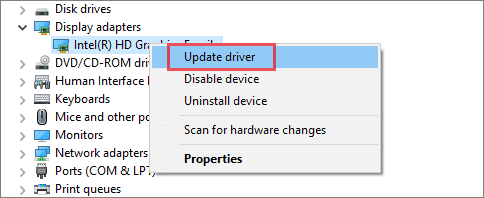
- Intel graphics driver has stopped working windows 7 drivers#
- Intel graphics driver has stopped working windows 7 driver#
- Intel graphics driver has stopped working windows 7 tv#
Intel graphics driver has stopped working windows 7 drivers#
Intel HD GPU is not the same and has DCH drivers from Intel.įor Gen4/5 Intel Core i3/I5/i7, they only provide WDM kernel drivers, fullyĬompatible with Windows 7/8/8.1 and all versions of Windows 10 up to MayĢ019 (including with Memory integrity enabled). You simply use an Intel CPU with Generation 6 or higher, whose interel Haswell-class processors in the market, including in servers and in many You are speaking about newer generations of Intel CPUs, there are a lot of This should continue to work for all Windows 10-WHQL certified drivers. Without delegating all to the default Windows kernel implementation.
Intel graphics driver has stopped working windows 7 driver#
Kernel mode drivers, that virtualization was offered by that driver itself, In user mode and virtualization by the windows kernel itself in Intel Many users don't have a display compatible with DCH drivers working purely Mode that allows WHQL display kernel drivers to continue working. I amĬonvinced that Microsoft can allow a "Memory integrity" compatible working Limitations applied now by the new "Memory integrity" feature. This was not a problem in past versions of Windows 10 that did not have the Wants to use the secure UEFI configuration and wants to "play" with memory It's only the OS itself that now no longer Requirement is also NOT part of secure UEFI boot where the UEFI driver Missing "shim", even if this has a small performance impact. Virtualization and serialization support in a Windows kernel, using a Memory integrity requirement needs to be fixed, possibly with Having to boot in non secure boot is definitely not an option. Version published by Intel in May 2019) are certified for Windows 10, butĭon't work now with Memory integrity force ON when Secure boot is used. Only have WHQL-certified drivers using kernel drivers. This is only available since generation 6. Intel does NOT provide ANY DCH driver for all its existing Core i3/i5/i7ĬPU/APUs. GitHub Login: Microsoft Alias: ellevin.Content Source: windows/security/threat-protection/device-guard/memory-integrity.md.C’est obligatoire pour ➟ Liaison des problèmes GitHub. And it is still sold and advertized as Windows 10 compatible and certified by Microsoft Hardware Labs. And I don't think that a 4-core Intel Core i7 is a "minor" or antique processor. This is a severe regression of Windows if it can no longer use an essential device built on many PCs with Intel processors. Removing safe boot or using an external display board is also NOT an option for any server (that should still be able to have at least a basic display capability.

The "solution" to boot in non-secure UEFI boot mode is NOT a solution (secure boot is required by lot of domains). Microsoft MUST work with Intel to make a compatible Windows driver, or at least be able to use the UEFI driver and its existing configuration (which is locked by UEFI).
Intel graphics driver has stopped working windows 7 tv#
for the desktop and for an external TV via HDMI) can no longer use the second display. We can't use any display driver after boot, not even the basic VGA driver, we finally have no display at all, unless we connect another graphics board on a PCI express bus (possible only in desktop, but graphics adapters are the most costly part of a PC). Intel Graphics Driver (integrated in the Intel core i7 processor)Įven if this display driver is WHQL signed, and is configured by the BIOS with a UEFI driver and enabled and used during the early boot while loading Windows, the handover during boot is not working, and the display stop working. This setting, now enforced in Windows when using UEFI safe boot mode, is now blocking an essential driver required by boot:


 0 kommentar(er)
0 kommentar(er)
